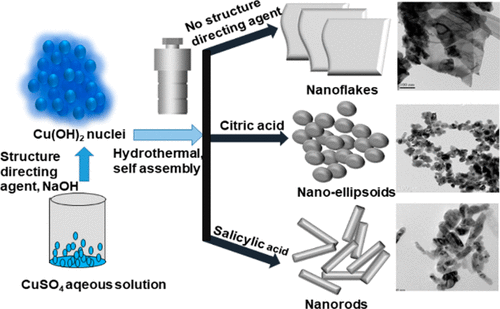当前位置:
X-MOL 学术
›
ACS Sustain. Chem. Eng.
›
论文详情
Our official English website, www.x-mol.net, welcomes your
feedback! (Note: you will need to create a separate account there.)
Comparative Study on the Morphology-Dependent Performance of Various CuO Nanostructures as Anode Materials for Sodium-Ion Batteries
ACS Sustainable Chemistry & Engineering ( IF 7.1 ) Pub Date : 2018-06-29 00:00:00 , DOI: 10.1021/acssuschemeng.8b02159 Purna Chandra Rath,Jagabandhu Patra,Diganta Saikia,Mrinalini Mishra,Chuan-Ming Tseng,Jeng-Kuei Chang,Hsien-Ming Kao
ACS Sustainable Chemistry & Engineering ( IF 7.1 ) Pub Date : 2018-06-29 00:00:00 , DOI: 10.1021/acssuschemeng.8b02159 Purna Chandra Rath,Jagabandhu Patra,Diganta Saikia,Mrinalini Mishra,Chuan-Ming Tseng,Jeng-Kuei Chang,Hsien-Ming Kao

|
In this work, CuO samples with three different nanostructures, i.e., nanoflakes, nanoellipsoids, and nanorods, are successfully synthesized by a facile and environmentally friendly hydrothermal approach based on the use of different structure directing agents. The morphological influence on the anodic electrochemical performances, such as capacity, cycling stability, rate capability, and diffusion coefficient measurements of these different CuO nanostructures is comparatively investigated for sodium-ion batteries. The capacity and cycling stability are higher for the CuO nanorods (CuO-NRs) based electrode as compared to the cases of CuO nanoellipsoids (CuO-NEs) and CuO nanoflakes (CuO-NFs). At a low current density of 25 mA g–1, the CuO-NRs based electrode exhibits an excellent reversible capacity of 600 mA h g–1. It also exhibits a capacity of 206 mA h g–1 after 150 cycles with a capacity retention of 73% even at a higher current density of 1000 mA g–1. The exceptional performance of CuO-NRs is attributable to its slim nanorod morphology with a smaller particle size that provides a short diffusion path and the maximized surface area facilitating good diffusion in electrolytes, ensuring good electronic conductivity and cycling stability. The comparative analysis of these materials can provide valuable insights to design hierarchical nanostructures with distinct morphology to achieve better materials designed for sodium-ion batteries.
中文翻译:

各种CuO纳米结构作为钠离子电池负极材料的形貌相关性能的比较研究
在这项工作中,使用不同的结构导向剂,通过简便且环保的水热方法成功合成了具有三种不同纳米结构的CuO样品,即纳米薄片,纳米椭圆体和纳米棒。对于钠离子电池,对这些不同的CuO纳米结构对阳极电化学性能(如容量,循环稳定性,倍率性能和扩散系数测量)的形态学影响进行了比较研究。与基于CuO纳米椭圆体(CuO-NEs)和CuO纳米薄片(CuO-NFs)的情况相比,基于CuO纳米棒(CuO-NRs)的电极的容量和循环稳定性更高。在25 mA g –1的低电流密度下,基于CuO-NRs的电极具有600 mA hg –1的出色可逆容量。在150次循环后,即使在更高的电流密度1000 mA g –1的情况下,它也表现出206 mA hg –1的容量,而容量保持率为73%。CuO-NRs的卓越性能归因于其细长的纳米棒形态,较小的粒径,较短的扩散路径和最大的表面积,有利于电解质中的良好扩散,从而确保了良好的电子导电性和循环稳定性。这些材料的比较分析可以提供有价值的见解,以设计具有独特形态的分层纳米结构,从而获得用于钠离子电池的更好材料。
更新日期:2018-06-29
中文翻译:

各种CuO纳米结构作为钠离子电池负极材料的形貌相关性能的比较研究
在这项工作中,使用不同的结构导向剂,通过简便且环保的水热方法成功合成了具有三种不同纳米结构的CuO样品,即纳米薄片,纳米椭圆体和纳米棒。对于钠离子电池,对这些不同的CuO纳米结构对阳极电化学性能(如容量,循环稳定性,倍率性能和扩散系数测量)的形态学影响进行了比较研究。与基于CuO纳米椭圆体(CuO-NEs)和CuO纳米薄片(CuO-NFs)的情况相比,基于CuO纳米棒(CuO-NRs)的电极的容量和循环稳定性更高。在25 mA g –1的低电流密度下,基于CuO-NRs的电极具有600 mA hg –1的出色可逆容量。在150次循环后,即使在更高的电流密度1000 mA g –1的情况下,它也表现出206 mA hg –1的容量,而容量保持率为73%。CuO-NRs的卓越性能归因于其细长的纳米棒形态,较小的粒径,较短的扩散路径和最大的表面积,有利于电解质中的良好扩散,从而确保了良好的电子导电性和循环稳定性。这些材料的比较分析可以提供有价值的见解,以设计具有独特形态的分层纳米结构,从而获得用于钠离子电池的更好材料。











































 京公网安备 11010802027423号
京公网安备 11010802027423号